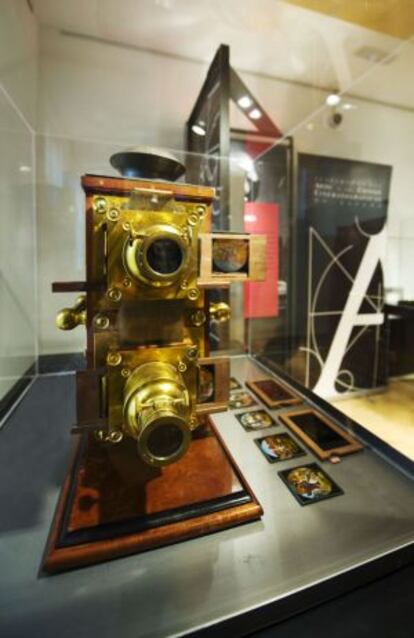Film’s forgotten ancestors
A look at the devices that preceded the Lumières’ invention

France is celebrating. It’s January 30, 1853 and Emperor Napoleon III has just married Eugénie de Montijo. A procession of soldiers squeezes along the tree-lined street to allow the royal couple to pass. With the Arc de Triomphe visible in the background, there are soldiers playing the flute and a gendarme on horseback; another two carry the French Tricolour: Vive l’empereur!
This entire spectacle fits inside a box of just a few cubic centimeters. That’s the size of the diorama that reveals a cardboard representation of the royal nuptials to anyone who puts their eye to the glass.
First, though, they will need to head to the Cinema Academy in Madrid where this and other examples of cinema’s predecessors star in a free exhibition titled Illusión y movimiento: los orígenes del cinematógrafo (or, Illusion and movement: the origins of cinema). From the Kinora to the praxinoscope, from the camera obscura to the magic lantern, this small show explores the greater- and lesser-known branches of cinema’s family tree. “It all began as a toy,” explains the Catalan cinema expert and collector Josep María Queraltó, who is the owner of all the contraptions on show.
Queraltó goes up to each of the devices and explains the workings behind the complicated name. Inside a megalethoscope you see how a photo of Venice changes from day to night every few seconds and a multiple stereoscopic viewfinder, you discover, is nothing less than an example of “3D ahead of its time,” as he puts it.
In fact Queraltó has only brought 15 pieces from his enormous personal collection of pre-cinema devices to the Cinema Academy. It is 22 years since he stopped some bulldozers about to pull down a movie theater and carried away the projectors that started his collection. Since then he has stored away 20,000 items. “The most recent one is a projector that arrived for me the other day that is for 22-centimeter-wide films,” he says. “If you have any cinema-related objects that you are going to throw away, bring them to me!”
“It’s an exhibition that above all provokes envy and an inferiority complex,” smiles Cinema Academy president and keen collector Enrique González Macho. It’s also one that, according to exhibition curator Luis Alonso, treads on terrain disputed by collectors and film historians. “Some studies would say these contraptions don’t strictly have anything to do with cinema technology,” he says. “But they do reflect its original idea.”
Each visitor picks their own side. Queraltó has already chosen his and now dreams about turning his collection into a museum devoted to cinema and audiovisual technology “that explains how cinema was arrived at.” It would be a fantastic story — like the ones hidden behind the glass of a diorama.
Illusión y movimiento: los orígenes del cinematógrafo. Until May 15 at Academia de cine, C/ Zurbano 3, Madrid. www.academiadecine.com
Tu suscripción se está usando en otro dispositivo
¿Quieres añadir otro usuario a tu suscripción?
Si continúas leyendo en este dispositivo, no se podrá leer en el otro.
FlechaTu suscripción se está usando en otro dispositivo y solo puedes acceder a EL PAÍS desde un dispositivo a la vez.
Si quieres compartir tu cuenta, cambia tu suscripción a la modalidad Premium, así podrás añadir otro usuario. Cada uno accederá con su propia cuenta de email, lo que os permitirá personalizar vuestra experiencia en EL PAÍS.
¿Tienes una suscripción de empresa? Accede aquí para contratar más cuentas.
En el caso de no saber quién está usando tu cuenta, te recomendamos cambiar tu contraseña aquí.
Si decides continuar compartiendo tu cuenta, este mensaje se mostrará en tu dispositivo y en el de la otra persona que está usando tu cuenta de forma indefinida, afectando a tu experiencia de lectura. Puedes consultar aquí los términos y condiciones de la suscripción digital.
Últimas noticias
More than 40 Democratic lawmakers urge Trump in a letter to stop his ‘attempts to undermine democracy in Brazil’
The journal ‘Science’ criticizes Trump’s anti-renewable energy policy: ‘The US is failing to benefit from its own innovations’
Cubans hope for a miracle as dengue and chikungunya spread
The long shadow of the father figure in the films of Rob Reiner
Most viewed
- Christian Louboutin: ‘Young people don’t want to be like their parents. And if their parents wear sneakers, they’re going to look for something else’
- Cartels in Mexico take a leap forward with narco-drones: ‘It is criminal groups that are leading the innovation race’
- ‘El Limones’ and the growing union disguise of Mexican organized crime
- Liset Menéndez de la Prida, neuroscientist: ‘It’s not normal to constantly seek pleasure; it’s important to be bored, to be calm’
- The low-cost creative revolution: How technology is making art accessible to everyone









































